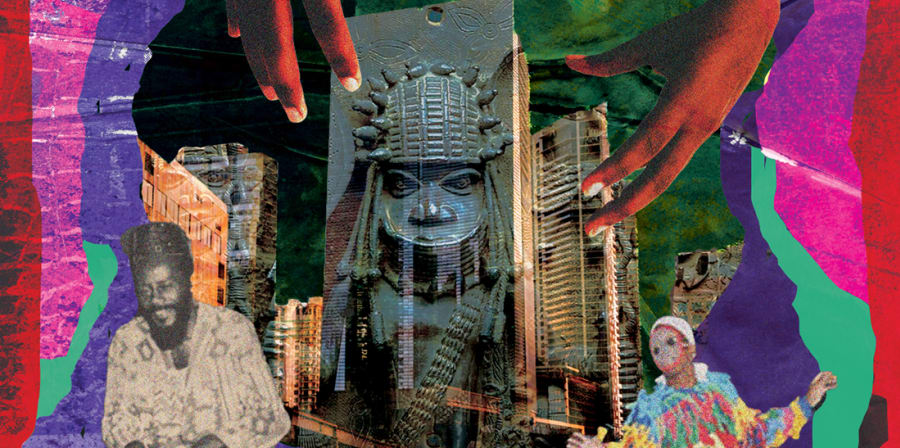Meet Hannah Smith: exploring folkloric connections between Africa and its diaspora

- Written byStudent Communications
- Published date 01 October 2024

Hannah Smith is one of three artists who worked with UAL's Brand and Creative team to create the collages for Black History Month this year.
We spoke to Hannah to discover the artist behind the work.
Hi Hannah! Please can you introduce yourself?
Hi, I’m Hannah and I’m a 21-year-old Illustration and Visual Media student at LCC. I’d best describe myself as a Jamaican-born, mixed media and conceptual artist who is passionate about engaging with the communities I inhabit through art and research.
How did your journey with art begin?
I’ve always been into the arts in some way, shape or form from a young age. I did ballet for 11 years and went onto modern dance, drama and synchronised swimming too. I started writing and that was kind of my gateway into the visual arts – I still write a lot to this day, and it has really informed my practice.
My creative practice consists of a lot of textile work, mixed media and conceptual work – which is where I find the most fulfilment and enjoyment.
I began incorporating textiles into my practice after exploring the folkloric and cultural connections between the Caribbean and West Africa. Due to enslavement, oral history stemming from the African continent provided the foundations of Caribbean history. In acknowledging the power of textiles and Indigenous knowledge – as tools for historical preservation, collective identity and decolonial practice – I wanted to explore the reclamation of this medium in a contemporary diasporic context.
What do you feel is your mission as an artist?
There are 2 quotes that I believe encapsulate my mission as an artist.
“Art-making as a means to mobilize the weapon. If armed struggle is the first action of finding a world beyond colonization, beyond what we can see, culture loads the gun. The role of the artist is to load the gun” – Ismatu Gwendolyn.
and
“The role of the artist as a guide whose responsibility is to evoke the art within others” – Anna Halprin.
Somewhere within those two quotes is where I believe my art practice lies.
What is your work about, and what messages do you convey through it?
Practices of storytelling, tradition and folklore are central themes in my practice, and I explore them through decentralized approaches to making, researching and documentation. The narratives I portray in my work visually allude to indigenous knowledge from African and diasporic culture, specifically the textile and sonic aspects of these histories.
Who are your primary inspirations?
My primary inspirations exist in the communities that I inhabit. I am inspired by the conversations I have with others on a daily basis about the material conditions of our environment and the black speculative concepts that reimagine those conditions not only for those racialized as black but for all marginalized identities.
What piece of yours stands out the most to you? Why?
‘I have told it the way I perceived it’ a screen printed and embroidered tapestry piece stands out most to me in my practice. This piece is what began my exploration of the folkloric connections between Africa and its diaspora as well as craft art as a catalyst for decolonial practice.
What achievements are you most proud of?
I’m really proud of my first solo exhibition entitled “We will not come in peace.” at the end of August- September 2024. I had the creative freedom to curate a gallery space in accordance with my intentions for the project which I was extremely grateful for. I also was able to host workshops that sparked needed conversations on dehumanization prevalent in systems such as healthcare and education in the UK as well as methods of weaning our reliance off these oppressive systems. In seeing the success of the workshops and exhibitions I aim on continuing to develop this project in the coming months.
What are you planning to do next?
I am currently at the start of my DPS year and hope to take time to experiment with the mixing of digital and tangible mediums as well as conduct more primary research on the indigenous knowledge practices that continue to influence my practice. I see many more workshops, collaborations and exhibitions in my future!
Why does the world need creativity?
I think the world needs creativity, because creativity makes knowledge accessible. As creatives we can shape worlds and communicate subjects in ways that connect to the emotions of a person. That is a special thing that must never be taken for granted. “If one could make people lose touch with their capacity to create, lose sight of their will and their power to make art, then the work of subjugation, of colonization, is complete.” Art on My Mind, bell hooks.
You’ve been selected as part of the Black History Month campaign for UAL. The theme is ‘Reclaiming narratives’- what does the month and the chosen theme mean to you?
To me, reclaiming narratives means the recovery of stories lost and untold in Black history and the ways in which Black history has been documented has been quite dismissive of how we want to be portrayed.
Indigenous knowledge as it pertains to African and African diasporic history has not been prioritised in our storytelling and valued as proper documentation of our stories.
The reclaiming narratives is the revaluing of non-western ways of archiving or history and having the autonomy to exist outside the colonising eye.

More
See more of Hannah's work. @halenatron
Find out more about Black History Month 2024 at UAL